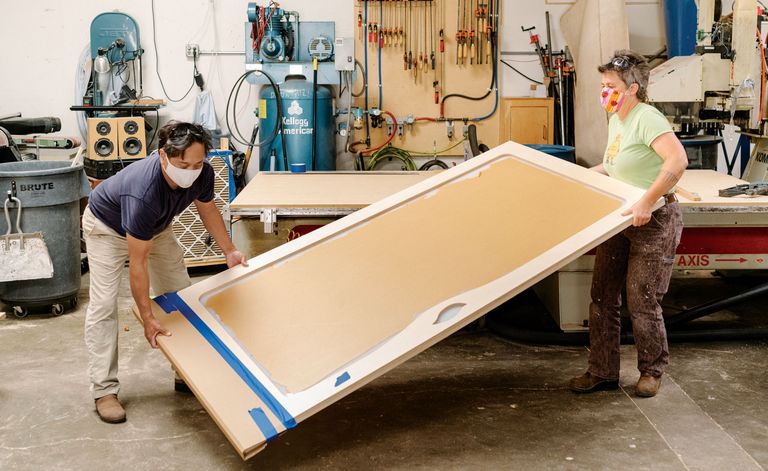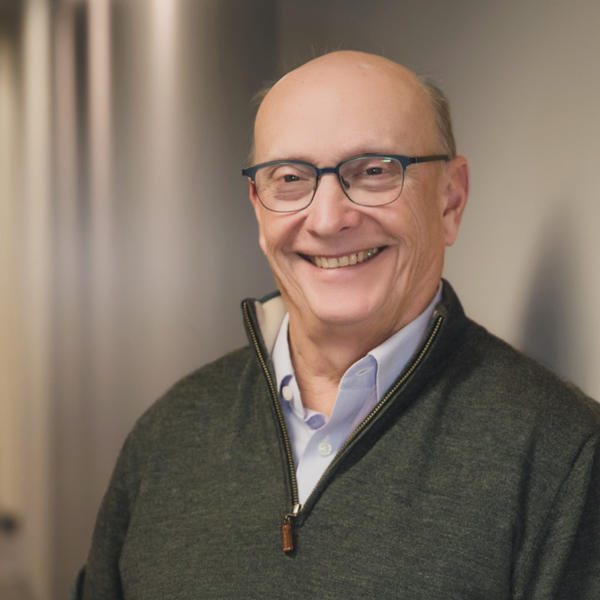Take No Prisoners – Designing Justice + Designing Spaces

This article is written by Lydia Lee from Alta Online
Architect Deanna Van Buren is building positive alternatives to the criminal justice system
Deanna Van Buren, a cofounder of Designing Justice + Designing Spaces, on the Murphy bed of a prototype modular housing unit for formerly incarcerated people.

At the end of May, in response to George Floyd’s murder, downtown Oakland was roiled by protests. Architect Deanna Van Buren and her team at the nonprofit Designing Justice + Designing Spaces had been working out of a ground-floor office located in the city center. After a night of turmoil, she and her DJDS cofounder, Kyle Rawlins, found that their workplace’s plate-glass window had been smashed. Rawlins, who has since left the organization, taped up a sign that said “This is a local Black-owned business.” “We should have put that sign up before, not after,” says Van Buren ruefully. She shared pictures of the damage in a Facebook post that reads, in part, “[We] will never give up our mission to end the violence and oppression embedded in our justice system and its built environment.”
The deaths of Floyd and so many more Black individuals, along with COVID-19, have highlighted the structural racism that has long galvanized advocates for prison abolition like Van Buren, who has been working on alternatives for nearly a decade. The United States holds the inglorious title of having more of its population imprisoned, per capita, than any other country; Black and brown inmates make up 56 percent of the prison population, and proportionally, Black people are imprisoned at six times the rate of white people. Prison abolition goes beyond criminal justice reform, calling for a radically different system that redirects resources from jails to address the root causes of crime: poverty, unequal access to education, lack of employment opportunities, mental health issues and drug addiction, and other contributing factors. Beyond the stark racial disparities of mass incarceration, proponents for ending it cite its ineffectiveness and inherent cruelty. “I hope that we find much more humane, constructive ways of responding to the real harms of violence and of crime than subjecting people to deliberate humiliation, stigmatization, suffering, and caging,” said The New Jim Crow author Michelle Alexander in an interview at the start of last year.
As an architect and a proponent of prison abolition, Van Buren helps fellow advocates visualize what can replace prisons. Her own experience fuels her passion for this work. She grew up in Virginia, where her family was the first to desegregate an all-white neighborhood. In kindergarten, after a boy tried to push her off the last remaining seat on the bus and called her a racial slur, she punched him. “Guess who got in trouble? Only me! Welcome to the South,” says Van Buren, laughing a little. In exploring her family tree, she found a forefather who was likely owned by Abraham Van Buren, the son of the eighth president of the United States (it was not uncommon for enslaved people to take their slaveholder’s surname).
Van Buren studied architecture as an undergrad at the University of Virginia, then earned a master’s at Columbia University. After working as an architect in London and Australia for several years, she moved to the Bay Area in 2005. She’s lived in Oakland for nearly 15 years now; these days, when she takes her dog, a white Lhasa apso–shih tzu mix named Gandalf, for a walk around the Grand Lake neighborhood, she passes many Black Lives Matter lawn signs and a handwritten placard in a window that reads “Band-Aids Cannot Fix Systemic Problems.”
In January 2007, she went to a Martin Luther King Jr. Day talk by activist Angela Davis and her sister, Fania, at a nearby church. The lecture turned out to be a passionate call for restorative justice, which is a linchpin of the prison abolition movement. Van Buren’s immediate reaction was “This is what we should be doing. Why aren’t we doing this?” (Van Buren’s own ability to captivate audiences can be seen in her 2017 TED Talk, “What a World Without Prisons Could Look Like,” which has received more than one million views.) In the conventional criminal justice system, crime is a violation against the state, which metes out punishment. Restorative justice, in which the offender and the victim confer on how to repair the harm done, is an increasingly popular way to address conflicts in school and juvenile cases in the United States; New Zealand has embraced it for handling adult cases.
A ROOM OF ONE’S OWN
A short drive from the DJDS office, in Oakland’s Fruitvale neighborhood, is Restore Oakland, which recently celebrated its one-year anniversary. Owned by two nonprofits, the center “is just one prototype amidst the extensive constellation of infrastructure you need to build instead [of prisons],” says Van Buren. DJDS handled the renovation of this 20,000-square-foot former office building, turning it into a community hub that serves working-class, lower-income Black and brown families. The ground floor is a restaurant and kitchen for job training; during the first few months of the pandemic, it became a commissary kitchen that prepared food for the school district and homeless neighbors. On the second floor, there are offices for a criminal justice reform advocacy group and a housing and immigration rights group. Before the shutdown, the basement was the liveliest floor, as various organizations and community groups met there in three large conference rooms, which are rented out on a sliding-scale basis.
Restore Oakland also has one of the first dedicated spaces in the country for restorative justice. A small, bright room painted a calm blue is the setting for community circles where offenders meet with victims, together with their families and a trained facilitator. Before everything went virtual in March, a handful of juvenile and emerging-adult cases diverted by the Alameda County District Attorney’s Office were resolved here; one of the key benefits to this approach is that offenders don’t end up with a criminal record and avoid the negative fallout from having one.
The DJDS team—10 full-time staff and around six consultants—currently spends most of its time on conceptual plans for larger projects. Much of the work is funded through philanthropy; as a nonprofit, DJDS channels donations to flesh out ideas for “community infrastructure reinvestment into fully realized designs and proposals,” per its website. But the organization is also set up to function as a developer for hire that can take projects from start to finish. Recently, DJDS hired Sydnee Freeman as director of real estate development; she brings nearly two decades of private-sector and affordable-housing development experience to the nonprofit.
In September, Van Buren and a couple of team members went on a weeklong road trip that included stops in Detroit and Ann Arbor, Michigan; Louisville, Kentucky; Jackson, Mississippi; and New Orleans to do in-depth site visits with potential clients. Detroit is key: DJDS is in contract to purchase an acre of land to build an expanded version of Restore Oakland a few miles from the city’s downtown. “We’ll be able to pilot new models—we’d love to do a de-escalation center,” says Van Buren, referring to police station alternatives.
Other current efforts include creating a glossary of more than 30 building types that the city of Los Angeles might invest in now that a large coalition of community groups has blocked the construction of a $2.2 billion jail-like mental health facility there. On the other side of the country, the hulking Atlanta City Detention Center is among a number of prisons whose closures were announced over the past couple of years, and DJDS is helping the city determine whether to renovate the nearly half-a-million-square-foot structure or tear it down and create a series of hubs that combine restorative justice with community resources that would be distributed throughout the area.
But there are also numerous immediate needs to be addressed. At the start of October, Van Buren is at a small machine shop, Neal’s CNC in Hayward, inspecting the seven-foot-tall Baltic birch plywood pieces of a mobile refuge room. The modular unit is a cost-effective way to carve out privacy for formerly incarcerated people. To improve reentry housing, the Alameda County Probation Department has commissioned 15 of the units for individuals who are currently sharing one large room at a church in Oakland. Each person will get their own semiprivate quarters, with a built-in Murphy bed, ample storage, and a door that slides closed. The handle cutouts are in the shape of leaves—a small detail that brings a sense of nature into the design, something that DJDS always strives to do.
The unit is also notable for its design process, which stressed user participation. In 2013, Van Buren and restorative justice researcher Barb Toews created a community engagement tool kit specifically for incarcerated people. Since then, the DJDS team has fine-tuned its implements and methods to generate conversations for various types of projects, including a Space Planning and Finance Game. In this case, the target users created life-size mock-ups with large pieces of cardboard and tape. “Most architects we work with will get input in terms of the idea, but then they’ll go off to their space and create it,” says Donald Frazier, executive director of the Berkeley nonprofit Building Opportunities for Self-Sufficiency, which operates this reentry-housing program.
“[The DJDS process] is amazing—it’s really engaging,” says Frazier, who previously worked with the organization on another housing project. “They’ve got a lot of props to help people verbalize their thoughts, so folks at any educational level can have their voices heard around the table. What emerges from the process is a project that you can see.”
Gerard Dumuk (left) and Rachel McConnell of Neal’s CNC, a machine shop in Hayward, California, work with materials for a mobile refuge room, DJDS’s project to provide reentry housing for formerly incarcerated people.

BUILD IT AND THEY WILL COME
While the practice of architecture often aims to maximize light and space in order to create feelings of well-being in users, these goals have taken on new meaning in the fight against systemic racism. In June, a group of architects, designers, and activists formed Design as Protest to decouple architecture from implicit white supremacy and anti-Black ideologies. A few months later, the New York chapter of the American Institute of Architects, the largest branch of the nationwide organization, called upon architects to stop designing prisons, jails, detention centers, and police stations. “We instead urge our members to shift their efforts towards supporting the creation of new systems, processes, and typologies based on prison reform, alternatives to imprisonment, and restorative justice,” its statement reads.
These actions breathe fire into the questions of what architects are building and for whom. “[DJDS’s] work is the most important and inspiring work that architects are doing to address racial justice in the country,” says architect Raphael Sperry, board secretary for the San Francisco–based advocacy group Architects/Designers/Planners for Social Responsibility and a DJDS board member. “For architects, the solution is always a building. They’ve felt like they’ve had no role to play. And until Deanna came along, it was hard to argue about that.”
As Van Buren and others assess the built environment that exists today, they’re elevating the role of designer as social justice advocate. “[The criminal justice system] is a multifaceted beast, and all of the changes—the public buy-in, the financial infrastructure for divestment and investment, policy reform—have to happen at the same time,” she says. “We can do it, if we learn how to work together.”



